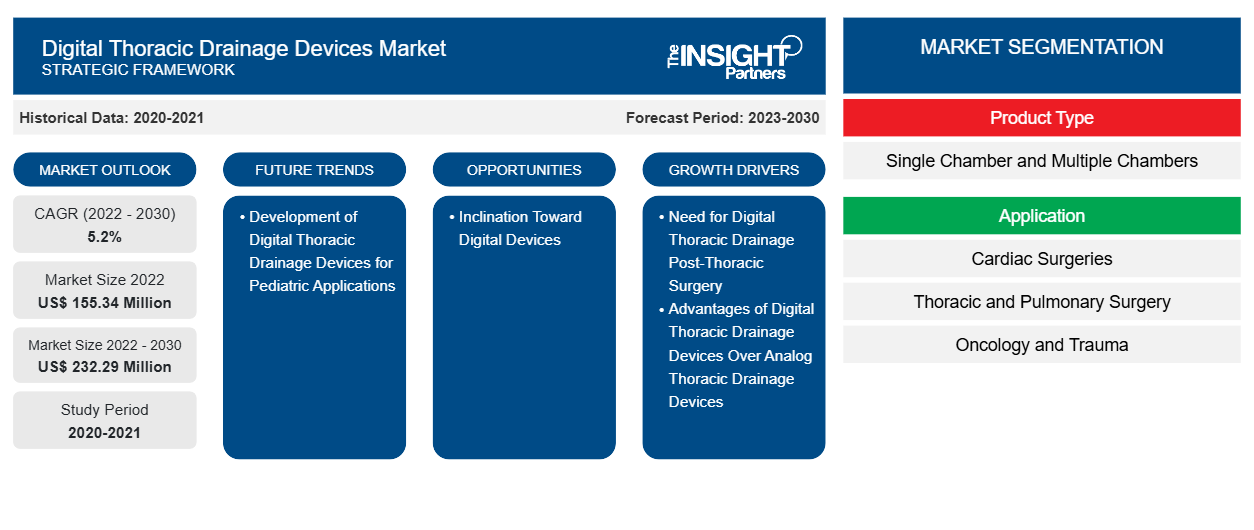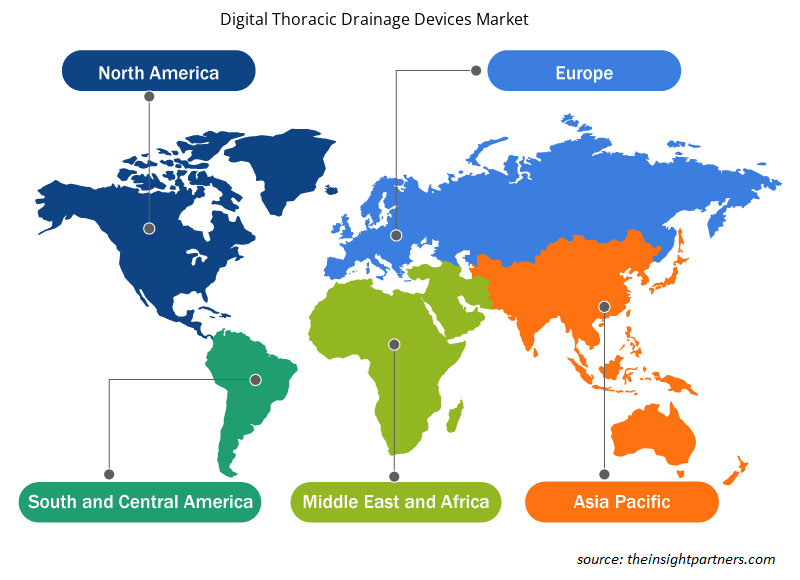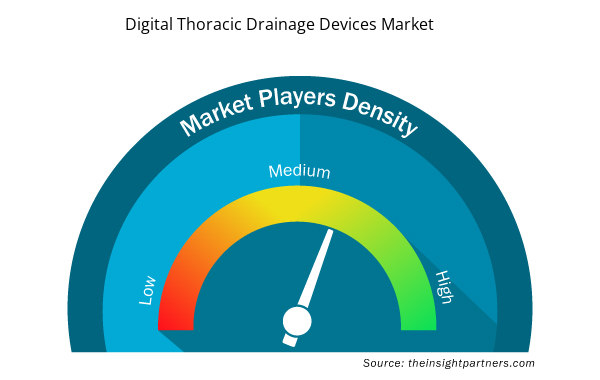[Research Report] The digital thoracic drainage devices market size is projected to reach US$ 232.29 million by 2030 from US$ 155.34 million in 2022. The market is expected to register a CAGR of 5.2% from 2022 to 2030.
Market Insights and Analyst View:
Digital chest drains provide precise, stable negative pressure irrespective to patient position without any obstruction of tubes. Thoracic or chest drainage helps maintain proper respiratory functions and hemodynamic stability by removing air, fluid, or blood from around the heart or lungs. These systems have several benefits over traditional systems. They allow the continuous recording of air leaks; this capability helps decrease variations associated with physicians’ judgments regarding the need for the removal of chest tubes. Thoracic drainage systems are primarily utilized to treat patients in intensive care units (ICUs), emergency departments, and operating rooms. An increase in acceptance of modern devices, a rise in the prevalence of cardiovascular diseases (CVDs), and a surge in the burden of spontaneous pneumothorax are major factors driving the digital thoracic drainage devices market growth. Digital thoracic drainage devices are safe, comfortable, and well-tolerated by patients. Moreover, they help reduce or eliminate the cost of hospital stays.
Growth Drivers and Opportunities:
The count of thoracic surgeries performed is increasing due to the rising incidence of lung cancer. ~80% of the total thoracic surgeries are performed for the treatment of different types of lung cancer. The major types of lung cancer include esophageal cancer and the cancers diagnosed in the pericardium, the chest wall, and mediastinum tumors. According to the World Cancer Research Fund International, lung cancer is the second most common cancer worldwide. The number of thoracic surgeries performed globally has increased notably with the prevalence of the disease and a surge in its diagnosis. According to the research article “A brief overview of thoracic surgery in the US,” published in the Journal of Thoracic Disease in January 2022, nearly 530,000 general thoracic surgeries are performed annually in the US. The number of thoracic surgeries would continue to increase in the coming years with the rising incidence of lung cancer. Thus, the demand for digital thoracic drainage devices is increasing with the rising incidence of lung cancer
The field of thoracic surgery is growing with advancements in relevant technologies and modifications in techniques to become a prominent specialty. Thoracic surgery has witnessed progress due to developments in minimally invasive approaches. Procedures such as elective segmentectomy, enhanced recovery programs, uniportal surgeries, and adjuvant target therapy allow treatments of early-stage lung cancer, resulting in a rising number of thoracic surgeries. Moreover, technical developments are leading to much better results of thoracic surgeries performed now compared to surgeries performed a decade ago. Most thoracic surgeries are performed robotically or by video-assisted thoracoscopic surgery (VATS) lobectomy, which results in fewer complications and faster recovery. Thoracic drainage devices are essential post-surgery to remove large air leakage and excessive fluid from the pleural cavity.
Apart from lung cancers, thoracic surgeries are performed for treating CVDs and other chronic diseases. These procedures also include first rib resection for thoracic outlet syndrome, myotomy for Achalasia, esophagectomy and reconstruction for end-stage benign esophageal disease, thymectomy for Myasthenia Gravis, sympathectomy for hyperhidrosis, and so on. These diseases are common among elderlies, and people suffering from respiratory disorders and other health conditions. Thus, a rise in the geriatric population triggers the number of thoracic surgeries performed as a treatment, thereby leading to the need for digital thoracic drainage devices.
Customize This Report To Suit Your Requirement
You will get customization on any report - free of charge - including parts of this report, or country-level analysis, Excel Data pack, as well as avail great offers and discounts for start-ups & universities
Digital Thoracic Drainage Devices Market: Strategic Insights

- Get Top Key Market Trends of this report.This FREE sample will include data analysis, ranging from market trends to estimates and forecasts.
Customize This Report To Suit Your Requirement
You will get customization on any report - free of charge - including parts of this report, or country-level analysis, Excel Data pack, as well as avail great offers and discounts for start-ups & universities
Digital Thoracic Drainage Devices Market: Strategic Insights

- Get Top Key Market Trends of this report.This FREE sample will include data analysis, ranging from market trends to estimates and forecasts.
Report Segmentation and Scope:
Based on product type, the digital thoracic drainage devices system market is bifurcated into single chamber and multiple chambers. Based on application, the market is segmented into thoracic and pulmonary surgery, infectious diseases, oncology and trauma, cardiac surgery, and others. The digital thoracic drainage devices market, by end user, is segmented into hospitals, ambulatory surgical centers, and others. In terms of geography, the digital thoracic drainage devices system market is segmented into North America (US, Canada, and Mexico), Europe (France, Germany, UK, Spain, Italy, and Rest of Europe), Asia Pacific (China, India, Japan, Australia, South Korea, and Rest of Asia Pacific), Middle East & Africa (Saudi Arabia, UAE, South Africa, and Rest of Middle East & Africa), and South & Central America (Brazil, Argentina, and Rest of South & Central America).
Segmental Analysis:
The digital thoracic drainage devices market, by product type, is bifurcated into single chamber and multiple chambers. The single chamber segment held a larger market share in 2022. Further, the multiple chambers segment is anticipated to register a higher CAGR during the forecast period. A single chamber system is the most basic design for a thoracic drainage system. It has one collection container, either a Heber-drain or an active suction source. The attachment of a water seal component allows for active or passive air evacuation. Manual assistance may be required when using a Heber-drain to ensure all air is sucked out. When the patient cannot exhale or cough up extra air, the height between the bed and the ground may need to be adjusted to prevent pneumothorax or subcutaneous emphysema. A few single-chamber systems have limitations when treating large air leaks since they are not always simple to detect, especially when the patient produces a lot of foam.
Based on application, the digital thoracic drainage devices market is segmented into thoracic and pulmonary surgery, infectious diseases, oncology and trauma, cardiac surgery, and others. The thoracic and pulmonary surgery segment held the largest market share in 2022, and it is anticipated to register the highest CAGR during the forecast period. The growing number of thoracic surgeries and pulmonary—including coronary artery bypass grafting, heart and lung transplants, and cancerous lung tissue excision—has propelled the adoption of thoracic drainage devices. According to the study titled "A brief overview of thoracic surgery in the United States," published in January 2022, ~530,000 general thoracic surgeries are performed annually in the US by nearly 4,000 cardiothoracic surgeons. Digital thoracic drainage devices aid in treating pleural effusions and empyema problems. As per the data published by the Asthma and Allergy Foundation of America in April 2022, 1 in 13 Americans suffer from asthma, i.e., ~26 million people in total. As a result, the demand for thoracic drainage devices is anticipated to rise during the forecast period. Thus, the above factors drive the digital thoracic drainage devices market growth for the thoracic and pulmonary surgery segment.
The digital thoracic drainage devices market, by end user, is segmented into hospitals, ambulatory surgical centers, and others. The hospitals segment held the largest market share in 2022, and it is anticipated to register the highest CAGR of 5.6% during the forecast period. Medical staff at hospitals offers convenient services and the best care to patients to restore and maintain good public health. Moreover, the staff members in these facilities are aware of different digital thoracic drainage devices used for various applications. They are also educated and trained to tackle the complications that may occur after using a new device. The increasing population has enhanced the demand for healthcare services, further propelling the need for hospitals and staff. Thus, the digital thoracic drainage device market for the hospitals segment is projected to experience significant growth during the forecast period.
Regional Analysis:
North America dominates the global digital thoracic drainage devices market. The North America digital thoracic drainage devices market size was US$ 51.10 million in 2022, and the market is projected to reach US$ 77.70 million by 2030; it is expected to grow at a CAGR of 5.4% during the forecast period. The North America digital thoracic drainage devices market is segmented into the US, Canada, and Mexico. The market growth in North America is attributed to the growing adoption of the latest medical device technologies, and the increasing incidences of chronic diseases such as lung cancer, cardiovascular diseases, and chronic respiratory diseases. In addition, the Mexican tourism sector is likely to offer opportunities for the digital thoracic drainage devices market growth in the region. Further, the Asia Pacific digital thoracic drainage devices market is segmented into China, Japan, India, South Korea, Australia, and the Rest of Asia Pacific. An increase in the digital thoracic drainage devices market size in the region is attributed to an upsurge in cases of respiratory disorders, a rise in the number of surgeries performed, the expansion of the healthcare sector, and the growing awareness of digital thoracic drainage devices.
Industry Developments and Future Opportunities:
Various initiatives taken by key players operating in the global digital thoracic drainage devices market are mentioned below.
- In February 2023, the Thoraguard Intelligent Chest Tube Management System, developed by Centese, Inc., was cited in a few peer-reviewed journals for its use following lung surgery. According to a study published in the Journal of Thoracic Disease by the thoracic surgery team at New York University Langone Health (NYU Langone Health), Thoraguard’s digital air leak measurement technology was more reliable and precise than conventional drainage devices, reducing hospital stays.
- In December 2020, Medela introduced the Thopaz+ Digital Chest Drain, which improved safety and helped prevent cross-contamination during the COVID-19 pandemic. Multiple quantitative tests have proven that the filtration system of Thopaz+ effectively blocks aerosolized viral particles such as SARS-CoV-2 through its filtration system. Through its filtration systems, patients and staff members could be protected from cross-contamination and transmission of infectious aerosols.
Digital Thoracic Drainage Devices Market Regional Insights
Digital Thoracic Drainage Devices Market Regional Insights
The regional trends and factors influencing the Digital Thoracic Drainage Devices Market throughout the forecast period have been thoroughly explained by the analysts at Insight Partners. This section also discusses Digital Thoracic Drainage Devices Market segments and geography across North America, Europe, Asia Pacific, Middle East and Africa, and South and Central America.

- Get the Regional Specific Data for Digital Thoracic Drainage Devices Market
Digital Thoracic Drainage Devices Market Report Scope
| Report Attribute | Details |
|---|---|
| Market size in 2022 | US$ 155.34 Million |
| Market Size by 2030 | US$ 232.29 Million |
| Global CAGR (2022 - 2030) | 5.2% |
| Historical Data | 2020-2021 |
| Forecast period | 2023-2030 |
| Segments Covered |
By Product Type
|
| Regions and Countries Covered | North America
|
| Market leaders and key company profiles |
Digital Thoracic Drainage Devices Market Players Density: Understanding Its Impact on Business Dynamics
The Digital Thoracic Drainage Devices Market market is growing rapidly, driven by increasing end-user demand due to factors such as evolving consumer preferences, technological advancements, and greater awareness of the product's benefits. As demand rises, businesses are expanding their offerings, innovating to meet consumer needs, and capitalizing on emerging trends, which further fuels market growth.
Market players density refers to the distribution of firms or companies operating within a particular market or industry. It indicates how many competitors (market players) are present in a given market space relative to its size or total market value.
Major Companies operating in the Digital Thoracic Drainage Devices Market are:
- Medela AG
- ATMOS MedizinTechnik GmbH & Co KG
- Centese Inc
- Redax SpA
- Rocket Medical Plc
Disclaimer: The companies listed above are not ranked in any particular order.

- Get the Digital Thoracic Drainage Devices Market top key players overview
Covid-19 Impact:
The COVID-19 pandemic affected economies and industries in various countries across the world. Lockdowns, travel restrictions, and business shutdowns in North America, Europe, Asia Pacific (APAC), South & Central America (SAM), and the Middle East & Africa (MEA) hampered the growth of several sectors, including the healthcare sector. The COVID-19 pandemic had a significant impact on the digital thoracic drainage devices market as well. As healthcare systems worldwide focused on managing the pandemic's surge, elective procedures such as certain thoracic surgeries were deferred or canceled, resulting in a temporary decline in demand for thoracic drainage devices. Moreover, disruptions in global supply chains caused delays in manufacturing and distribution, leading to shortages and increased costs for these devices. However, these advanced devices play a critical role in treating conditions such as pleural effusion and pneumothorax, which can occur as severe complications of COVID-19. By effectively draining excess fluid or air from the pleural space, these devices help relieve pressure on the lungs and promote respiratory recovery. Additionally, the digital capabilities of these devices enable remote monitoring of patients' drainage output and other relevant parameters, allowing healthcare professionals to assess their progress and respond promptly to any changes. This remote patient management approach has been crucial in minimizing direct contact between patients and healthcare workers, contributing to infection control efforts during the pandemic. Overall, digital thoracic drainage devices have significantly improved patient outcomes and provided essential support to healthcare systems facing unprecedented challenges during the early stages of the COVID-19 pandemic.
Competitive Landscape and Key Companies:
A few of the prominent players operating in the digital thoracic drainage devices market include Medela AG, ATMOS MedizinTechnik GmbH & Co KG, Centese Inc, Redax SpA, Rocket Medical Plc, Getinge AB, Teleflex Inc., Pacific Hospital Supply Co Ltd, Cardinal Health Inc, and Digicare Biomedical Technology Inc. These companies focus on new product launches and geographic expansions to meet the growing consumer demand worldwide and increase their product range in specialty portfolios. They have a widespread global presence, which helps them serve a large and varied clientele and subsequently expand their market share. The report offers a trend analysis of the digital thoracic drainage devices market, emphasizing parameters such as technological advancements, market dynamics, and competitive landscape analysis of leading market players worldwide.
- Historical Analysis (2 Years), Base Year, Forecast (7 Years) with CAGR
- PEST and SWOT Analysis
- Market Size Value / Volume - Global, Regional, Country
- Industry and Competitive Landscape
- Excel Dataset



Report Coverage
Revenue forecast, Company Analysis, Industry landscape, Growth factors, and Trends

Segment Covered
Product Type, Application, End User, and Geography

Regional Scope
North America, Europe, Asia Pacific, Middle East & Africa, South & Central America

Country Scope
Argentina, Australia, Brazil, Canada, China, France, Germany, India, Italy, Japan, Mexico, Saudi Arabia, South Africa, South Korea, Spain, United Arab Emirates, United Kingdom, United States
Frequently Asked Questions
A digital thoracic drainage device helps reduce the incidence of prolonged air and fluid leaks. A digital drainage device significantly shortened the duration of chest drainage and length of hospital stay in patients who underwent pulmonary resection. A digital thoracic drainage device is more advanced than a conventional thoracic drainage device as it can measure and display air and fluid leakage rates. In addition, it also provides 24-hour trends after thoracic surgery.
The growth of the global digital thoracic drainage devices market is attributed to a few key factors, such as the need for digital thoracic drainage post-thoracic surgery and the advantages of digital thoracic drainage devices over analog thoracic drainage devices.
North America region is dominating the digital thoracic drainage devices market in terms of market share and Asia Pacific is anticipated to register the highest CAGR during the forecast period.
The digital thoracic drainage devices market majorly consists of the players such as Medela AG; Getinge AB; ATMOS MedizinTechnik GmbH & Co KG; Centese Inc; Teleflex Inc; Redax SpA; Rocket Medical Plc; Pacific Hospital Supply Co Ltd; Cardinal Health Inc, and Digicare Biomedical Technology Inc.

 Get Free Sample For
Get Free Sample For